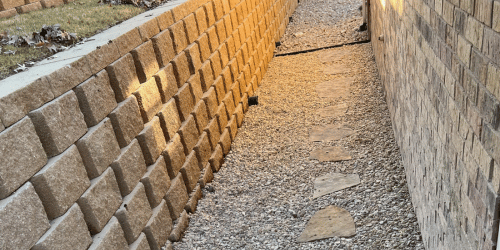Your landscape is an essential aspect of your home’s aesthetic appeal and functionality. Among the many elements you can incorporate, retaining walls play a pivotal role in preventing soil erosion, managing water flow, and providing aesthetic value. In the heart of McKinney, Texas, understanding the different types of retaining walls and choosing the right one can profoundly impact your landscape’s longevity and beauty.
Key Takeaway:
The best retaining wall for your landscape needs is dependent on the soil type, desired aesthetic, structural requirements, and environmental conditions specific to McKinney, Texas. Understanding these aspects will guide your decision-making process.
Understanding Retaining Walls
Types, Purposes, Basic Construction
Types:
There are several types of retaining walls, such as gravity walls, cantilevered walls, anchored walls, and piling walls. Each has its unique design and mechanism to hold the soil back.
Purposes:
Beyond just holding back soil, retaining walls aid in water management, create leveled terraces for gardening, and can be aesthetic features in your landscape.
Basic Construction:
Constructing a retaining wall typically involves site analysis, excavation, foundation laying, and building the wall with suitable materials like concrete, stone, wood, or bricks.
The Soil Factor
Types of Soil, Soil Analysis, Interaction with Retaining Walls
Types of Soil:
McKinney, Texas, may have various soil types, including sandy, clayey, loamy, and silty soils. Each soil type has its characteristics affecting the retaining wall’s design.
Soil Analysis:
Before building a retaining wall, a thorough soil analysis is vital to understand its bearing capacity, drainage properties, and potential expansion or contraction.
Interaction with Retaining Walls:
The type of soil determines the pressure exerted on the wall and its drainage characteristics, which in turn affects the wall’s design and drainage provisions.
Aesthetic Considerations
Design, Materials, Landscaping Integration
Design:
The design of your retaining wall can range from simple and functional to intricate patterns and shapes that add a touch of elegance to your landscape.
Materials:
From natural stone and timber to interlocking concrete blocks, the material you choose will define the wall’s look and longevity.
Landscaping Integration:
Incorporating the retaining wall seamlessly into your landscape design, perhaps with plantings or lighting from a company like Pristine Landscaping & Lighting, can enhance its beauty manifold.
Environmental Considerations
Weather Conditions, Drainage, Sustainability
Weather Conditions:
McKinney’s weather conditions, including rainfall and temperature variations, play a role in choosing the materials and design of the retaining wall.
Drainage:
Proper drainage provisions ensure that the retaining wall remains stable and free from water-induced damages.
Sustainability:
Opt for eco-friendly materials and designs that not only serve the purpose but also contribute positively to the environment.
Maintenance & Longevity
Regular Checkups, Repairing, Lifespan
Regular Checkups:
Routine inspections help in early detection of issues like cracks, tilts, or drainage blockages.
Repairing:
Addressing minor issues promptly can save substantial costs and prolong the wall’s life.
Lifespan:
With proper construction and maintenance, some retaining walls can last several decades.
Cost Factors
Material Cost, Labor Charges, Long-term ROI
Material Cost:
The choice of material, from natural stone to precast concrete, can significantly influence the total cost.
Labor Charges:
Depending on the complexity and size of the wall, labor charges can vary.
Long-term ROI:
Investing in a well-designed and constructed retaining wall can enhance property value and save future repair and reconstruction costs.
Answering Common Questions:
Can I build a retaining wall myself?
While smaller retaining walls can be DIY projects, for larger walls, especially in challenging terrains, it’s recommended to seek professional assistance for optimal results.
How high can a retaining wall be?
Retaining walls can be as high as needed, but walls over four feet typically require special engineering considerations and permits.
Do retaining walls need drainage?
Yes, drainage is essential to prevent water buildup, which can exert pressure and compromise the wall’s integrity.
The Impact of Weather Conditions:
McKinney’s varying weather conditions can influence the material’s durability, the need for drainage solutions
Conclusion:
Retaining walls are more than just functional barriers; they’re integral aspects of our landscapes that offer protection, beauty, and enhanced utility to our outdoor spaces. Their varied designs range from simple blocks that hold back soil to intricate structures that blend seamlessly into the surroundings, enhancing the overall aesthetic of a property.
At the heart of choosing the right retaining wall lies the understanding of soil types. As we’ve discussed, McKinney, Texas boasts a range of soil types, each with its distinct characteristics. Whether it’s the water retention capability of clayey soil or the excellent drainage offered by sandy soil, recognizing these characteristics is paramount in deciding the design, drainage systems, and material of the retaining wall.
Furthermore, aesthetics and environmental considerations go hand-in-hand. While the beauty of a retaining wall significantly depends on its design and material, its long-term success is influenced by its harmony with the environment. Weather conditions in McKinney, ranging from heavy rainfall to dry spells, impact the durability and functionality of these walls.
Maintenance, of course, is key. Like any structure, retaining walls require regular check-ups to ensure they remain in optimal condition. This proactive approach not only prevents potential issues but also saves homeowners from incurring heavy costs in the long run.
Lastly, a well-constructed retaining wall is an investment. Beyond its immediate benefits, it contributes positively to property value, ensuring homeowners receive an excellent return on their investment.
To put it succinctly, the best retaining wall for your landscape needs is a harmonious blend of functionality, aesthetics, and environmental compatibility, tailored specifically to McKinney’s unique soil and weather conditions.
For more information and personalized guidance on retaining walls tailored to your specific landscape needs, visit us at Pristine Landscaping & Lighting. We’re here to provide you with top-notch landscaping solutions and expert insights to make your outdoor space truly shine.






